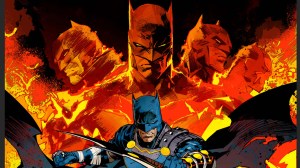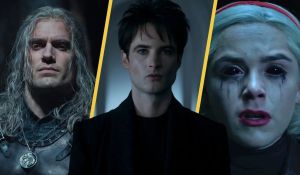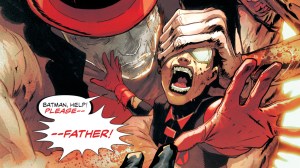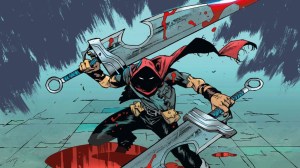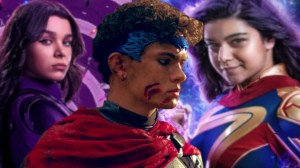Batman is getting a fresh new take this fall with Batman #1 from the creative team of Matt Fraction and Jorge Jiménez. The book hits this September and while it’s not exactly a reboot — Batman #1 will continue the status quo for Batman and Gotham that Chip Zdarsky laid out in his run, which itself built on the runs of James Tynion IV and Tom King before it — it will offer a strikingly different approach to the iconic DC superhero. Back is the legendary blue and gray suit and, perhaps most exciting, the series will feature fully contained stories in each issue that, when taken together with continuing issues in the series, accrue to tell a larger story as well. This is set to be a Batman for every reader, new and seasoned, and coming off of the Summer of Superman, Batman autumn is poised to a fresh and exciting time for readers.
Videos by ComicBook.com
ComicBook recently had a chance to sit down with Fraction to talk about Batman. With early looks at the series revealing a slick, neo-futuristic Gotham that is bright, colorful, and quite unlike anything we’ve seen before, as well as plenty of action and familiar but fresh faces, we had plenty of questions about this glittering, new beginning for one of DC’s most beloved characters — and Fraction had a lot to say.
Read on for our 10 big questions with Matt Fraction about Batman — and maybe one fun bonus question as well.
Nicole Drum, ComicBook: What was your North star in deciding what villains from the Rogues Gallery that you ended up using for your Batman?
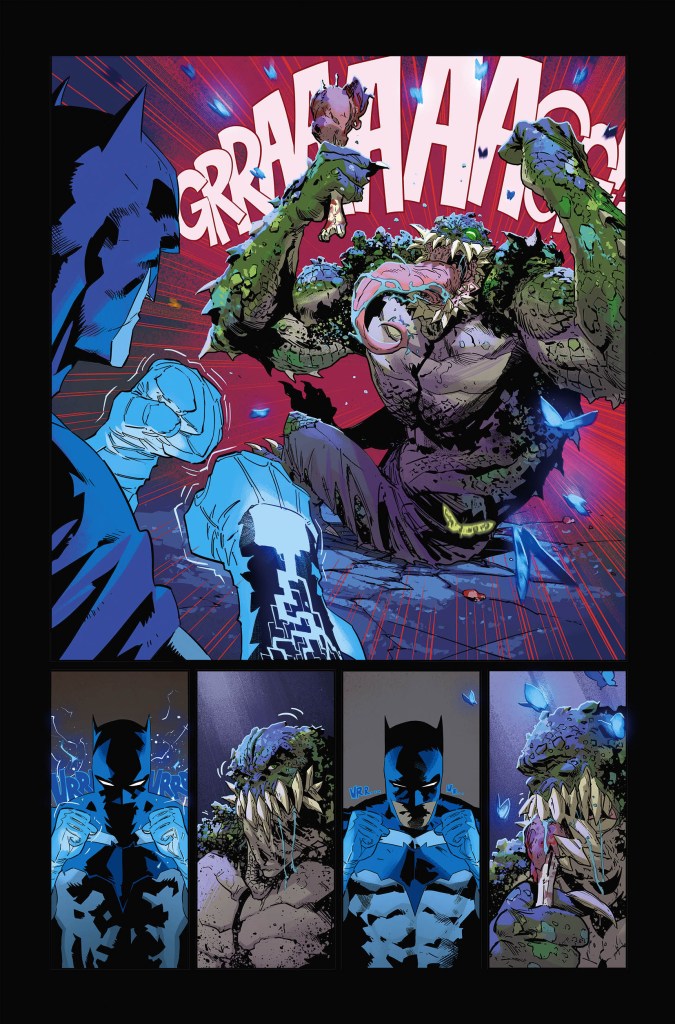
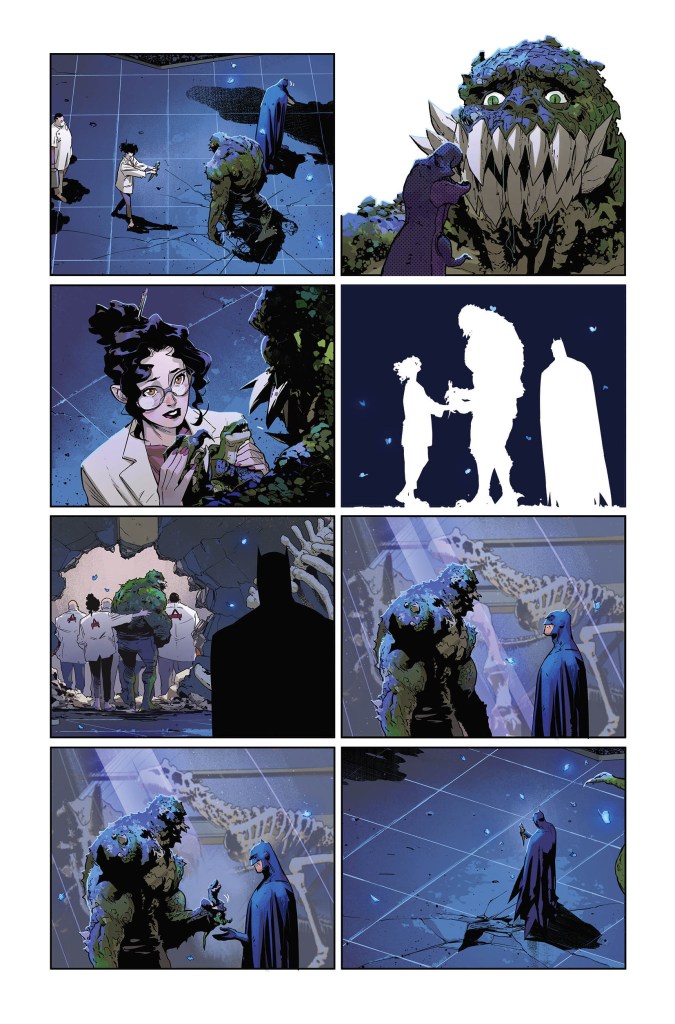
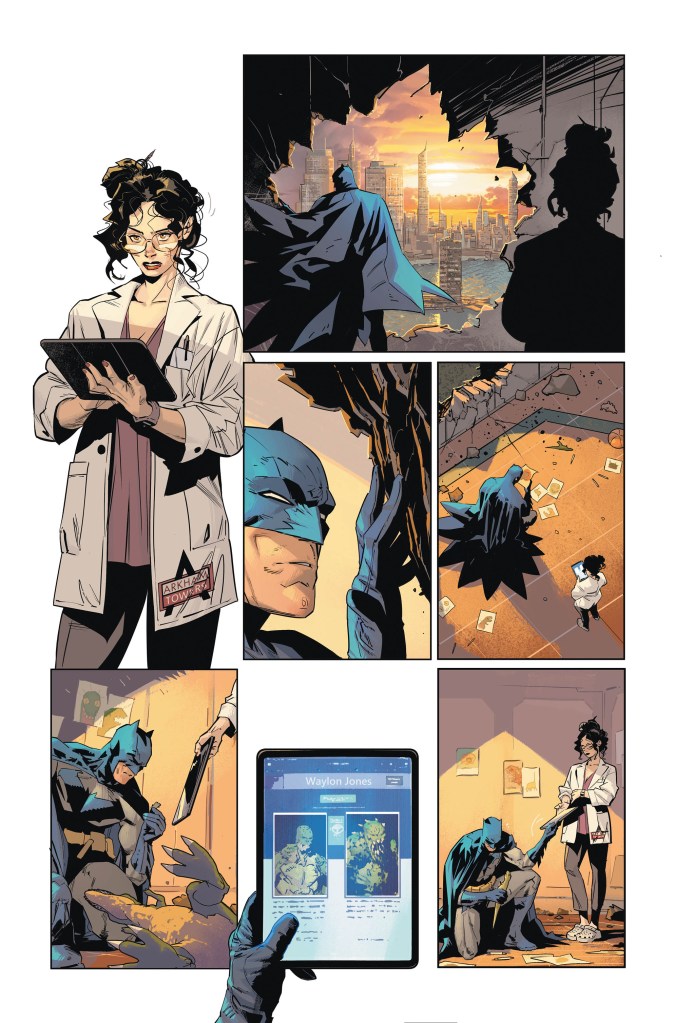
Matt Fraction: It is a plethora, a cornucopia, a horn of plenty sailors delight red skies at night, all you can eat buffet, right? Some of it is mechanics. I have a lot of crazy thoughts about first issues and second issues, but trying to come up with a thesis statement for the story, what the series will kind of hopefully be in my mind was what can we really change? What cycles are we trapped in? What’s nurture? What’s nature? Where is our choice perpetuating things? Combined with some of the stuff that’s been happening in Poison Ivy the last couple of years made it feel like, oh, I can something about change with Killer Croc and the idea of like a reptile shedding its skin and becoming something new. Even if he just kind of restores to mean, to what he was before, that there’s a chance to have a character literally evolving before our eyes, and not knowing what that means for him and for Croc not to know what it means for him to be stunted and afraid, and sort of like a massive, furious, terrified child with brand new skin. So, that was like, there’s just the mechanics of what the theme of the issue is and all that made sense there. And then it’s kind of… I have a list of things in my notebook. I have a notebook, I’ve already filled a notebook on this book, but like a list in there of just things I think it’d be cool to see Jorge draw just as a fan of Jorge’s and then kind of go back and kind of reverse engineer the casting, like oh, who would that be? Who would have that thing or this guy or that guy or whatever.
It’s Batman. I want to make up my own and contribute my own rogues. I have a couple of the DK Publishing encyclopedias and a whole wall of my own collections of stuff and I’ll just pick up a book and flip through and ‘oh, that guy’s awesome, let’s do that.’ I said this at San Diego [Comic-Con] but I feel like I’ve been locked in a Toys R Us after hours, and they don’t know I’m in here, and I’m just running down the aisles touching every single thing. My north star has been a deep, abiding love for all of them.
Which Gotham rogue, or citizen, in your run might mess with reader expectations? I mean, you said you’re in the toy store. Might as well play with the toys.

Hopefully, all of them. Hopefully I can bring something new. That’s kind of a cop-out answer, but also, I’m not wanting to tip my hand too much, but I hope to bring something new to all of them and find a way that they can all coexist in this one kind of world. I think that’s kind of the most exciting thing about actually getting to write the character, discovering very quickly there’s a reason not only why he’s lasted 85 years or whatever but that it’s such a resilient, elastic concept.
Grant [Morrison] famously said at the onset of their run ‘oh wait, what if you had actually lived through all this stuff? What would it do to you?’ And I think there’s some part of me that is like, what if all that stuff is still happening? What if it’s Killer Croc today and then it’s a squad of ninja assassins on motorcycles tomorrow, and then it’s cartel gangs. It’s a little bit like, we can do it all. We can sample from all of it, so with everybody that comes up I hope to find a way to have them function in a way that we recognize but bring something new to it. There’s a fun Riddler appearance and I immediately realized the Riddler is a trap of a character to write because you have to write all the riddles and it’s hard to do. But I think there’s a kind of a fun spin on Riddler soon, and that was interesting to me, just trying to write the book I would want to read. And if the Batman is that elastic, the rogues are as well.
Your Batman is embracing his colorful, dare I say, less gloomy side. Why is your Batman less noir and more neon?
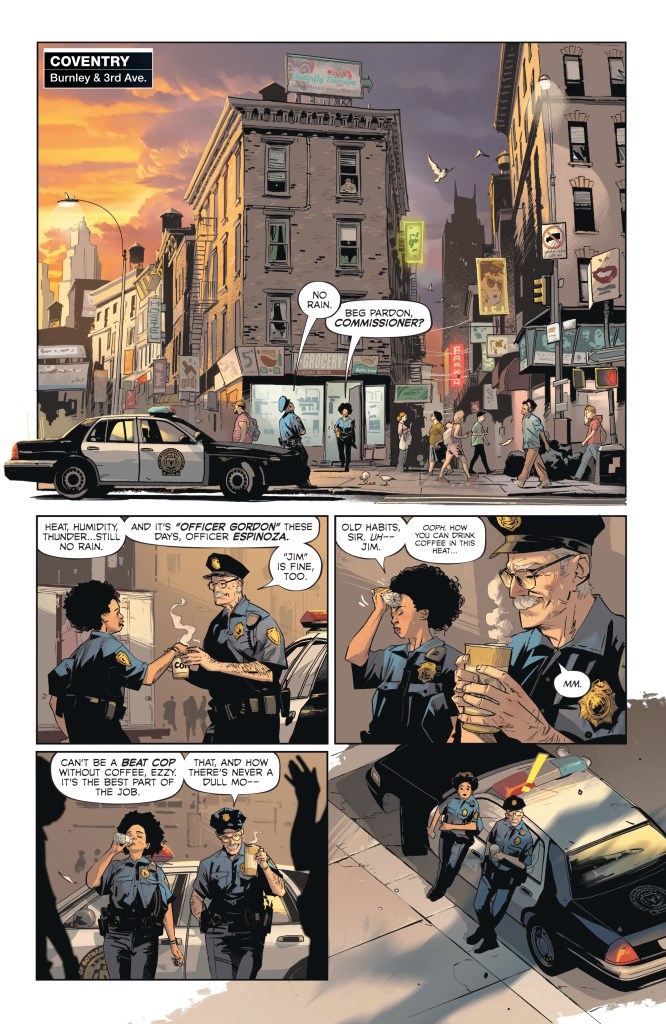
I think it’s Neon Noir, right? I think it’s Pop Noir, but it is, and that comes from a couple of places. One, I guess as a reader, I feel like we’ve had almost two decades of Gotham being the color of a rotten avocado. The first line in the book is “no rain” and I got to spend a lot of time in Tokyo not long ago, working on Monarch: Legacy of Monsters and had been there before but I was struck by the quality of light everywhere you went in the city, even as different as all the different neighborhoods and districts were. They are all unique and have such different character but they’re just such crazy qualities of light in the same city.

So, I wanted to see a thing we hadn’t seen a while. I wanted to do something new and fun and interesting, and I think that one of the great gifts of the DC Universe is that unlike the kind of hoary hacky writer’s cliche of the city is a character, in DC it’s true. It’s not New York. It’s Metropolis. It’s not Chicago. It’s Gotham. And I wanted to be like, why do people live here if it looks like an avocado all the time? It’s like it’s depressed so part of it is wanting to treat Gotham itself as a vita and exciting, evolving, changing character.
My first comic when I was 3 years old was Batman #316 and I’m sure that got more of a psychic imprint on my psyche than anything. But that’s the kind of era I came in and it feels like one we’ve not really gotten in a while. Like, for a long time the best pitch I had for the book was just to be like the blue and gray. He’s back in blue and gray because it’s still a crime book and could still be a horror book but still be a superhero. It’s superhero horror, it’s superhero action. [Batman] is a superhero so, I wanted to write a superhero Batman, not only because that’s the Batman that made me love Batman and love the comics, but it’s been a while.
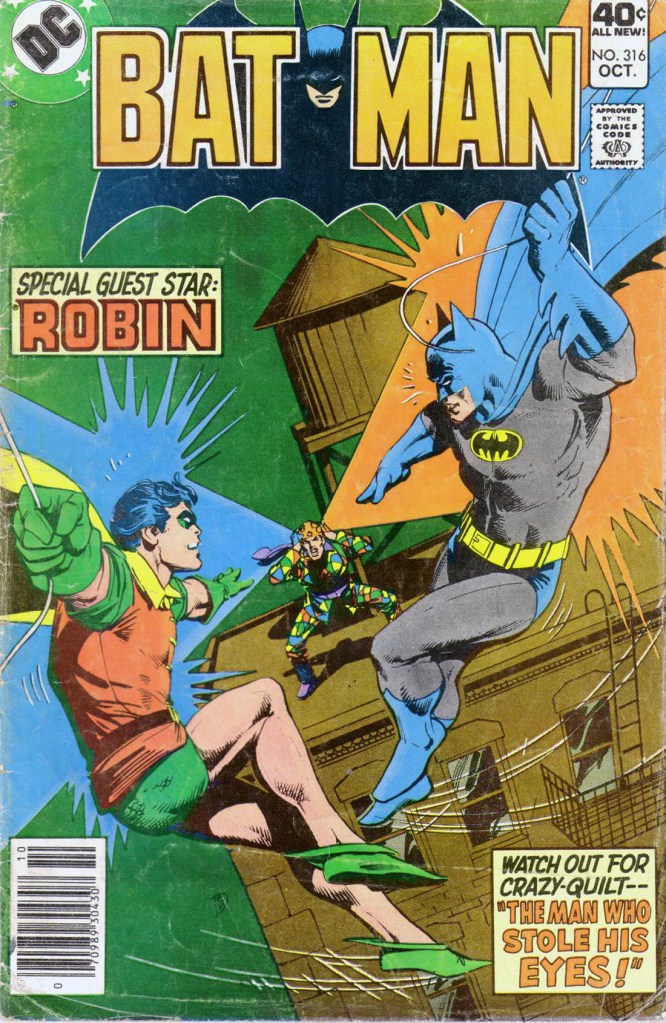
Since Bruce Wayne is so heavily associated with Batman, in one word, sum up your Bruce Wayne.
Crowded.
Rob [Levins] and Marie [Javins] asked if I had any thoughts about Batman and like, I’m the kind of writer where where I will… I famously had pitched on Hawkeye and then quit, like withdrew my name because I realized I didn’t have a run, I just had a story and then I figured out what the run was, right, and that all worked out well. So, it’s kind of where it starts, with well, if I’m gonna spend who knows how long with this guy in my head, what’s the on ramp? What’s the thing, and it occurred to me that if you wanted to kill Batman you would make Bruce Wayne happy. And the night that Bruce Wayne things, oh, maybe I don’t have to go out tonight is catastrophic. So, Batman and Bruce are like two roommates that are stuck together. The enduring survival of each means the enduring doom of the other. So, how do these guys live together?
And how do Batman and Bruce, that dichotomy… I’ve said this a lot, but the book is a two-hander. My two leads are Batman and Bruce Wayne. There are certainly other and supporting characters, but they’re all backseat to Batman and Bruce and this kind of split identity and if Bruce Wayne gets happy, what if Batman stops? So, it’s an on ramp. It’s a sketch. It’s the start.
Speaking of crowded, Batman’s gadgets and all of that are infamously either crazy fantasy prepared for everything or extremely practical. What is your approach to the Bat gadgets and is there a Batman gadget that you’re excited to bring into this world?
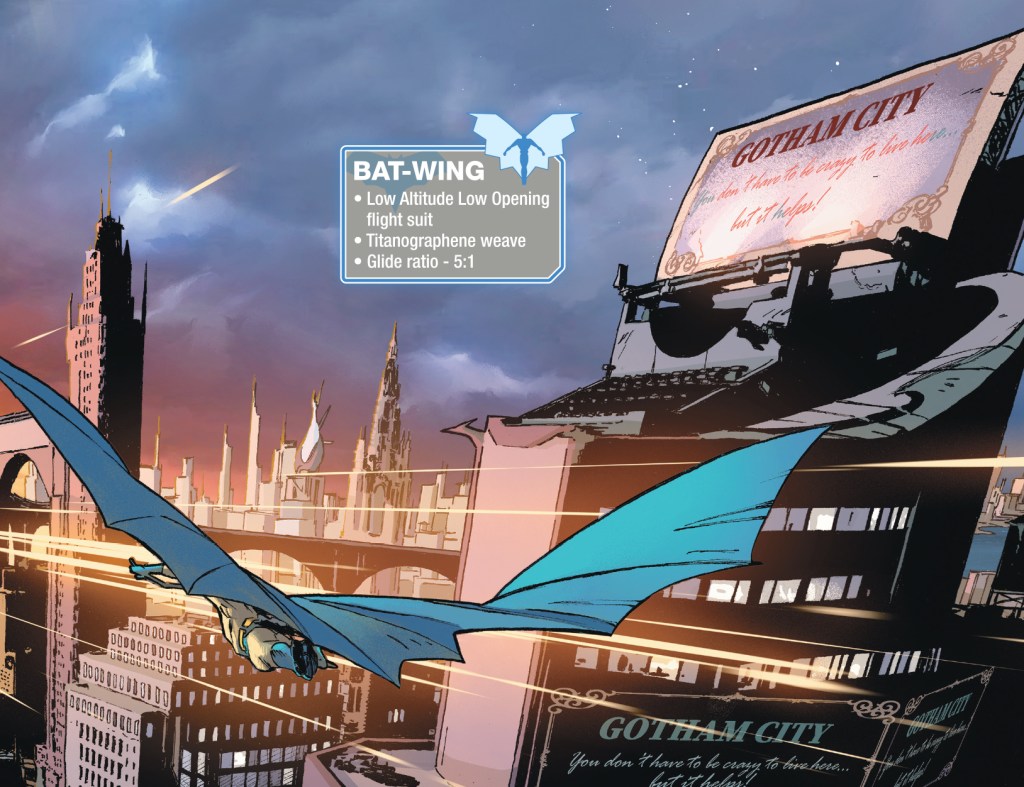
It’s such an integral part of the character to me, which definitely speaks to my age and sort of where I came in, before I kind of understood the camp and the funniness of like Batman ’66. I loved that everything was labeled for reader convenience. I loved that everything in the Batcave had a big label on it, oh that’s what that thing does, that’s what that thing does. It feels as much a part of the character as like, James Bond having Q Branch at his beck and call so I wanted to bring that in and Jorge had this sort of idea, like I did a thing with X-Men because I had to make it so my dad understood what was going on and rather than have characters explain to one another who they are, I would do these things and I called them in the script, Dad Caps, and it was like a little fun fact, little blurb. So, I had the idea to do that with the gadgets in this. And Jorge created a little weapon wheel design like it’s a video game like it’s Batman selecting through his equipment inventory so, anytime he uses something, there’s a little data call out. It tells you what the thing is and what it does and how it works, and all that stuff. So, because that was just such a part of the mystique and the charm and the fun of the character, oh, yeah, he’s got a f-cking utility belt. It is a belt filled with utilities. What are those?
Is there a favorite one? Yes, but I can’t say what it is because it’d be a spoiler, but I’m also acutely aware of like, he can’t have Bat shark repellent when he’s out. He can’t have it all at the same time. So, there’s also the temptation, it’s like having a get out of jail free card like, I can’t do that. But there’s also something similar to Hawkeye. He’s a regular guy. Yeah, he trains and he’s real good and smart and all that stuff, but he can’t fight a 2000 pound alligator man that wants to eat him. He’s got to do something more, that’s gonna require a little something. So, finding that stuff and finding those moments and letting it be a way to buy our guys into the superhero action. In the second issue, there’s a bit where Robin’s got these like, grip boots as part of how he scurries away and it’s just little things like that, ‘oh, I can have the regular people be a little superhero-y with the help of these gadgets.’ They’re all included, but we’ve even extended it to different costumes and stuff like that. I think it’s in three, there’s a brand-new costume for a scene and it has a very specific function, but I didn’t indicate that it was, oh it’s a new costume. Jorge just saw the opportunity like, ‘oh great, it’s another gadget.” And so it’s like, oh, Batman’s got this amazing wardrobe so part of just the joy of playing in the sandbox is like, yeah man, let’s invent new toys and make all this stuff happen.
I just like Batman that has stuff and I like that Batman has cool, smart, clever stuf that makes him more than just a guy.
Speaking of Jorge and the visuals…
Very handsome, speaking of visuals, [Jorge’s] very handsome.
Pretend for a moment that someone is low vision or they’re blind and can’t really see the art. Describe the art in this book for those folks.
It’s kinetic. It feels like velocity. Kinetic, electric. Everything has a kind of sizzle and crackle like ozone and there’s an aura to it, there’s an airiness. There’s space and a sense of movement through space, like bodies moving underwater where you can sort of feel the path of the motion. I think it’s incredibly visual. I think Jorge is absolutely brilliant, and he’s an incredible storyteller and just as a fan of his, every issue is a chance for me to write the ultimate Jorge Jiménez Batman issue.
In a very real way, this Batman is going to be a jumping on point for a lot of readers. What is your hope for new readers coming into your Batman?
I love the idea that a 9-year-old can read this and not be freaked out or not understand it. Part of the reason of this first span of issues, there are ongoing storylines that build and accrue, but each issue was like a done in one adventure and wanting to bring as many people in and make it as accessible as possible and really making it a true number one. It’s okay if you don’t know what else is going on, you might have questions about how people got to places, but I don’t think you need to know how Jim Gordon ended up being a beat cop. Hey now, the guy who used to be a Commissioner is the beat cop and the bad guy is the Commissioner, right? Like I love that, I love that, having this opportunity and I hope it’s accessible to Bat fans past, present, and future and not just accessible, but satisfying and good.
I wouldn’t be here if it wasn’t for Batman so let’s make a book that 42 years from now, someone is writing because this was their first one and it made them love comics for life.
You’ve mentioned that first comic for you that set a tone and has been an influence, it’s been an inspiration. What is something else that influenced your Batman that might surprise readers?
A psychoanalytic writer named [Jean] Leplanche. Just in thinking about how to write the character of Bruce and Batman, not to write the adventures, now how to write the comic stuff, but like who this dude I’m gonna spend all this time with. He’s in my head now so I gotta try to figure him out a little bit.
There’s a Powell and Pressburger film called A Matter of Life or Death or Stairway to Heaven, depending on your country, and John Alton’s cinematography in that. It’s like one of the most beautiful technicolor films ever made, like it’s just if there could be a comic in dayglow technicolor, I think it should be this one.
And somehow, for trying to get it away from Blade Runner, it’s only become more like Blade Runner. It rained a lot in Blade Runner, but there’s a lot of neon. Which is funny
I sort of noticed the other day it’s like if my complaint was we’re only listening to half the lessons, half the visual lessons of Blade Runner, now we’re maybe listening to the other half a lot more But yeah, technical cinematography somehow.
What has been, for you, the best thing about writing Batman?
To be candid, that it turns out I’ve been thinking about Batman all of my life and now I’ve fooled people into paying me to do it. It doesn’t feel like work and it’s still not real to me on some level. It might be until the book comes out.
I didn’t know it but turns out [I’ve] got stuff to say about Batman. So, it’s just been great. It’s been fun. It’s been really fun. It doesn’t feel like work.
And I have a very silly question. What do you think Batman would order at Dunkin’ Donuts?
Black coffee. That or like, an Americano with three extra shots, but no sugar, no milk. Blackest, darkest dark, the dark roast.
Does Bruce Wayne order the same thing?
No, Bruce would go out of his way to order a frou-frou drink. Bruce would be the guy who somehow mastered the $17 Dunkin’ drink. It’d be very bespoke and like ‘oh, could you take just a little bit of ice out? Thank you.’ And you know Bruce wouldn’t touch it. He got it for Alfred.
Batman #1, written by Matt Fraction with art by Jorge Jiménez, goes on sale September 3rd.


